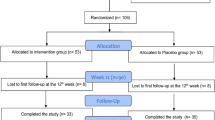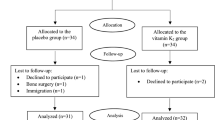Abstract
In recent years, our knowledge regarding the physiological role of vitamin K has expanded beyond regulation of coagulation to include many other aspects of human health. In the present review, we aimed to evaluate the existing evidence for beneficial effects of vitamin K on type 2 diabetes and components of the metabolic syndrome as risk factors for cardiovascular disease. Increased dietary intake of vitamin K has been linked to lower incidence of type 2 diabetes mellitus (T2DM), possibly through its enhancement of insulin production and sensitivity. Additionally, higher plasma levels of vitamin K1 have been associated with lower T2DM risk and decreased insulin resistance, and supplementation trials also suggest a positive influence of vitamin K on glucose regulation. Vitamin K might also beneficially affect serum lipids and lipid metabolism. However, the available data remain controversial. Additionally, different studies use different approaches to assess vitamin K status owing to the absence of a generally accepted marker, which further complicates data evaluation. In conclusion, vitamin K possibly improves glucose and lipid metabolism and could be an emerging target in the context of prevention and control of T2DM, insulin resistance, and dyslipidemia.
Similar content being viewed by others
Abbreviations
- T2DM:
-
Type 2 diabetes mellitus
- FFQ:
-
Food frequency questionnaire
- OGTT:
-
Oral glucose tolerance test
- HOMA-IR:
-
Homeostatic model assessment-insulin resistance
- HOMA-β:
-
Homeostatic model assessment-β cell function
- ucOC:
-
Undercarboxylated osteocalcin
- cOC:
-
Carboxylated osteocalcin
- HbA1c:
-
Glycated hemoglobin
- HDL-C:
-
High-density lipoprotein-cholesterol
- TRG:
-
Triglycerides
References
Dam H (1935) The antihaemorrhagic vitamin of the chick. Biochem J 29(6):1273–1285. https://doi.org/10.1042/bj0291273
Almquist HJ (1936) Purification of the antihemorrhagic vitamin by distillation. J Biol Chem 115:589–591
Bolton-Smith C, Price RJ, Fenton ST, Harrington DJ, Shearer MJ (2000) Compilation of a provisional UK database for the phylloquinone (vitamin K1) content of foods. Br J Nutr 83(4):389–399. https://doi.org/10.1017/S0007114500000490
Schurgers LJ, Geleijnse JM, Grobbee DE, Pols HAP, Hofman A, Witteman JCM et al (1999) Nutritional intake of vitamins K1 (phylloquinone) and K2 (menaquinone) in the Netherlands. J Nutr Environ Med 9(2):115–122. https://doi.org/10.1080/13590849961717
Suttie JW (1995) The importance of menaquinones in human nutrition. Annu Rev Nutr 15:399–417. https://doi.org/10.1146/annurev.nu.15.070195.002151
Nakagawa K, Hirota Y, Sawada N, Yuge N, Watanabe M, Uchino Y et al (2010) Identification of UBIAD1 as a novel human menaquinone-4 biosynthetic enzyme. Nature. 468(7320):117–121. https://doi.org/10.1038/nature09464
Thijssen HH, Drittij-Reijnders MJ (1996) Vitamin K status in human tissues: tissue-specific accumulation of phylloquinone and menaquinone-4. Br J Nutr 75(1):121–127. https://doi.org/10.1079/bjn19960115
McKee RW, Binkley SB, MacCorquodale DW, Thayer SA, Doisy EA (1939) The isolation of vitamins K1 and K2. J Am Chem Soc 61(5):1295. https://doi.org/10.1021/ja01874a507
Rishavy MA, Berkner KL (2012) Vitamin K oxygenation, glutamate carboxylation, and processivity: defining the three critical facets of catalysis by the vitamin K-dependent carboxylase. Adv Nutr 3(2):135–148. https://doi.org/10.3945/an.111.001719
Oldenburg J, Marinova M, Müller-Reible C, Watzka M (2008) The vitamin K cycle. Vitam Horm 78:35–62. https://doi.org/10.1016/S0083-6729(07)00003-9
Shearer MJ, Newman P (2014) Recent trends in the metabolism and cell biology of vitamin K with special reference to vitamin K cycling and MK-4 biosynthesis. J Lipid Res 55(3):345–362. https://doi.org/10.1194/jlr.R045559
Ho HJ, Shirakawa H, Hirahara K, Sone H, Kamiyama S, Komai M (2019) Menaquinone-4 amplified glucose-stimulated insulin secretion in isolated mouse pancreatic islets and INS-1 rat insulinoma cells. Int J Mol Sci 23:20(8). https://doi.org/10.3390/ijms20081995
Sakamoto N, Wakabayashi I, Sakamoto K (1999) Low vitamin K intake effects on glucose tolerance in rats. Int J Vitam Nutr Res 69(1):27–31. https://doi.org/10.1024/0300-9831.69.1.27
Khalil A, Youssef GA, Al-Saeed HF (2013) Protective role of vitamin K against impaired glucose homeostasis in ovariectomized exercised and nonexercised rats. Nat Sci 11(12):230–238
Hussein AG, Mohamed RH, Shalaby SM, Abd El Motteleb DM (2018) Vitamin K2 alleviates type 2 diabetes in rats by induction of osteocalcin gene expression. Nutrition. 47:33–38. https://doi.org/10.1016/j.nut.2017.09.016
Dihingia A, Ozah D, Ghosh S, Sarkar A, Baruah PK, Kalita J et al (2018) Vitamin K1 inversely correlates with glycemia and insulin resistance in patients with type 2 diabetes (T2D) and positively regulates SIRT1/AMPK pathway of glucose metabolism in liver of T2D mice and hepatocytes cultured in high glucose. J Nutr Biochem 52:103–114. https://doi.org/10.1016/j.jnutbio.2017.09.022
Sogabe N, Maruyama R, Baba O, Hosoi T, Goseki-Sone M (2011) Effects of long-term vitamin K(1) (phylloquinone) or vitamin K(2) (menaquinone-4) supplementation on body composition and serum parameters in rats. Bone. 48(5):1036–1042. https://doi.org/10.1016/j.bone.2011.01.020
Pitsillides AA, Blake SM, Glynn LE, Bitensky L, Chayen J (1990) Amelioration by menadione of the experimental chronic immune arthritis in the rabbit. Cell Biochem Funct 8(4):221–226. https://doi.org/10.1002/cbf.290080406
Reddi K, Henderson B, Meghji S, Wilson M, Poole S, Hopper C et al (1995) Interleukin 6 production by lipopolysaccharide-stimulated human fibroblasts is potently inhibited by naphthoquinone (vitamin K) compounds. Cytokine. 7(3):287–290. https://doi.org/10.1006/cyto.1995.0034
Ohsaki Y, Shirakawa H, Hiwatashi K, Furukawa Y, Mizutani T, Komai M (2006) Vitamin K suppresses lipopolysaccharide-induced inflammation in the rat. Biosci Biotechnol Biochem 70(4):926–932. https://doi.org/10.1271/bbb.70.926
Shea MK, Booth SL, Massaro JM, Jacques PF, D’Agostino RB Sr, Dawson-Hughes B et al (2008) Vitamin K and vitamin D status: associations with inflammatory markers in the Framingham Offspring Study. Am J Epidemiol 167(3):313–320. https://doi.org/10.1093/aje/kwm306
Bellido-Martín L, de Frutos PG (2008) Vitamin K-dependent actions of Gas6. Vitam Horm 78:185–209. https://doi.org/10.1016/S0083-6729(07)00009-X
Korshunov VA (2012) Axl-dependent signaling: a clinical update. Clin Sci (Lond) 122(8):361–368. https://doi.org/10.1042/CS20110411
Dihingia A, Ozah D, Borah T, Kalita J, Manna P (2020) Gamma-glutamyl–carboxylated Gas6 mediates positive role of vitamin K on lowering hyperglycemia in type 2 diabetes. Ann N Y Acad Sci 1462(1):104–117. https://doi.org/10.1111/nyas.14238
Bordoloi J, Ozah D, Bora T, Kalita J, Manna P (2019) Gamma-glutamyl carboxylated Gas6 mediates the beneficial effect of vitamin K on lowering hyperlipidemia via regulating the AMPK/SREBP1/PPARα signaling cascade of lipid metabolism. J Nutr Biochem 70:174–184. https://doi.org/10.1016/j.jnutbio.2019.05.006
Dihingia A, Jatin Kalita J, Manna P (2017) Implication of a novel Gla-containing protein, Gas6 in the pathogenesis of insulin resistance, impaired glucose homeostasis, and inflammation: a review. Diabetes Res Clin Pract 128:74–82. https://doi.org/10.1016/j.diabres.2017.03.026
O’Connor EM, Durack E (2017) Osteocalcin: The extra-skeletal role of a vitamin K-dependent protein in glucose metabolism. JNIM. 7:8–13. https://doi.org/10.1016/j.jnim.2017.01.001
Lin X, Brennan-Speranza TC, Levinger I, Yeap BB (2018) Undercarboxylated osteocalcin: experimental and human evidence for a role in glucose homeostasis and muscle regulation of insulin sensitivity. Nutrients. 10(7):847. https://doi.org/10.3390/nu10070847
Beulens JW (2010) van der A DL, Grobbee DE, Sluijs I, Spijkerman AM, van der Schouw YT. Dietary phylloquinone and menaquinones intakes and risk of type 2 diabetes. Diabetes Care 33(8):1699–1705. https://doi.org/10.2337/dc09-2302
Ibarrola-Jurado N, Salas-Salvadó J, Martínez-González MA, Bulló M (2012) Dietary phylloquinone intake and risk of type 2 diabetes in elderly subjects at high risk of cardiovascular disease. Am J Clin Nutr 96(5):1113–1118. https://doi.org/10.3945/ajcn.111.033498
Yoshida M, Booth SL, Meigs JB, Saltzman E, Jacques PF (2008) Phylloquinone intake, insulin sensitivity, and glycemic status in men and women. Am J Clin Nutr 88(1):210–215. https://doi.org/10.1093/ajcn/88.1.210
Sakamoto N, Nishiike T, Iguchi H, Sakamoto K (1999) Relationship between acute insulin response and vitamin K intake in healthy young male volunteers. Diabetes Nutr Metab 12(1):37–41
Santos EAD, Giudici KV, França NAG, Peters BSE, Fisberg RM, Martini LA (2020) Correlations among vitamin K intake, body fat, lipid profile and glucose homeostasis in adults and the elderly. Arch Endocrinol Metab. https://doi.org/10.20945/2359-3997000000230
Shim JS, Oh K, Kim HC (2014) Dietary assessment methods in epidemiologic studies. Epidemiol Health 22(36):e2014009. https://doi.org/10.4178/epih/e2014009
Centi AJ, Shea MK, Gundberg C, Saltzman E, Kritchevsky S, Asao K, et al. (2015) The association between vitamin K status and markers of insulin resistance in older adults: The Health, Aging and Body Composition Study. Association of vitamin K with insulin resistance and body composition. Tufts Digital Library. http://hdl.handle.net/10427/010806.
Ferland G, Sadowski JA, O’Brien ME (1993) Dietary induced subclinical vitamin K deficiency in normal human subjects. J Clin Invest 91(4):1761–1768. https://doi.org/10.1172/JCI116386
Booth SL, Suttie JW (1998) Dietary intake and adequacy of vitamin K. J Nutr 128(5):785–788. https://doi.org/10.1093/jn/128.5.785
Presse N, Gaudreau P, Greenwood CE, Kergoat MJ, Morais JA, Payette H et al (2012) A single measurement of serum phylloquinone is an adequate indicator of long-term phylloquinone exposure in healthy older adults. J Nutr 142(10):1910–1916. https://doi.org/10.3945/jn.112.164608
Shearer MJ (1992) Vitamin K metabolism and nutriture. Blood Rev 6(2):92–104. https://doi.org/10.1016/0268-960x(92)90011-e
Usui Y, Tanimura H, Nishimura N, Kobayashi N, Okanoue T, Ozawa K (1990) Vitamin K concentrations in the plasma and liver of surgical patients. Am J Clin Nutr 51(5):846–852. https://doi.org/10.1093/ajcn/51.5.846
Zwakenberg SR, Remmelzwaal S, Beulens JWJ, Booth SL, Burgess S, Dashti HS et al (2019) Circulating phylloquinone concentrations and risk of type 2 diabetes: a mendelian randomization study. Diabetes. 68(1):220–225. https://doi.org/10.2337/db18-0543
Centi AJ, Shea MK, Gundberg C, Booth SL, Saltzman E (2015) Circulating Undercarboxylated Osteocalcin is Not Associated with HOMA-IR. Association of vitamin K with insulin resistance and body composition. Tufts Digital Library. http://hdl.handle.net/10427/010806.
Kumar R, Binkley N, Vella A (2010) Effect of phylloquinone supplementation on glucose homeostasis in humans. Am J Clin Nutr 92(6):1528–1532. https://doi.org/10.3945/ajcn.2010.30108
Yoshida M, Jacques PF, Meigs JB, Saltzman E, Shea MK, Gundberg C et al (2008) Effect of vitamin K supplementation on insulin resistance in older men and women. Diabetes Care 31(11):2092–2096. https://doi.org/10.2337/dc08-1204
Rasekhi H, Karandish M, Jalali MT, Mohammad-Shahi M, Zarei M, Saki A et al (2015) The effect of vitamin K1 supplementation on sensitivity and insulin resistance via osteocalcin in prediabetic women:a double-blind randomized controlled clinical trial. Eur J Clin Nutr 69(8):891–895. https://doi.org/10.1038/ejcn.2015.17
Choi HJ, Yu J, Choi H, An JH, Kim SW, Park KS et al (2011) Vitamin K2 supplementation improves insulin sensitivity via osteocalcin metabolism: a placebo-controlled trial. Diabetes Care 34(9):e147. https://doi.org/10.2337/dc11-0551
Sakamoto N, Nishiike T, Iguchi H, Sakamoto K (2000) Possible effects of one week vitamin K (menaquinone-4) tablets intake on glucose tolerance in healthy young male volunteers with different descarboxy prothrombin levels. Clin Nutr 19(4):259–263. https://doi.org/10.1054/clnu.2000.0102
Shea MK, Booth SL, Gundberg CM, Peterson JW, Waddell C, Dawson-Hughes B et al (2010) Adulthood obesity is positively associated with adipose tissue concentrations of vitamin K and inversely associated with circulating indicators of vitamin K status in men and women. J Nutr 140(5):1029–1034. https://doi.org/10.3945/jn.109.118380
Dam V, Dalmeijer GW, Vermeer C, Drummen NE, Knapen MH, van der Schouw YT et al (2015) Association between vitamin K and the metabolic syndrome: a 10-year follow-up study in adults. J Clin Endocrinol Metab 100(6):2472–2479. https://doi.org/10.1210/jc.2014-4449
Knapen MHJ, Jardon KM, Vermeer C (2018) Vitamin K-induced effects on body fat and weight: results from a 3-year vitamin K2 intervention study. Eur J Clin Nutr 72(1):136–141. https://doi.org/10.1038/ejcn.2017.146
Pan Y, Jackson RT (2009) Dietary phylloquinone intakes and metabolic syndrome in US young adults. J Am Coll Nutr 28(4):369–379. https://doi.org/10.1080/07315724.2009.10718099
Kolahi S, Pourghassem GB, Mesgari AM, Asghari JM, Ghamarzad SN (2015) Effects of phylloquinone supplementation on lipid profile in women with rheumatoid arthritis: a double blind placebo controlled study. Nutr Res Pract 9(2):186–191. https://doi.org/10.4162/nrp.2015.9.2.186
Kristensen M, Kudsk J, Bügel S (2008) Six weeks phylloquinone supplementation produces undesirable effects on blood lipids with no changes in inflammatory and fibrinolytic markers in postmenopausal women. Eur J Nutr 47(7):375–379. https://doi.org/10.1007/s00394-008-0737-4
Nagasawa Y, Fujii M, Kajimoto Y, Imai E, Hori M (1998) Vitamin K2 and serum cholesterol in patients on continuous ambulatory peritoneal dialysis. Lancet. 351(9104):724. https://doi.org/10.1016/S0140-6736(05)78492-0
Schurgers LJ, Barreto DV, Barreto FC, Liabeuf S, Renard C, Magdeleyns EJ et al (2010) The Circulating inactive form of matrix Gla protein is a surrogate marker for vascular calcification in chronic kidney disease: a preliminary report. Clin J Am Soc Nephrol 5(4):568–575. https://doi.org/10.2215/CJN.07081009
Author information
Authors and Affiliations
Corresponding author
Ethics declarations
Conflict of interest
The authors declare that they have no conflict of interest
Additional information
Publisher’s note
Springer Nature remains neutral with regard to jurisdictional claims in published maps and institutional affiliations.
Rights and permissions
About this article
Cite this article
Varsamis, N.A., Christou, G.A. & Kiortsis, D.N. A critical review of the effects of vitamin K on glucose and lipid homeostasis: its potential role in the prevention and management of type 2 diabetes. Hormones 20, 415–422 (2021). https://doi.org/10.1007/s42000-020-00268-w
Received:
Accepted:
Published:
Issue Date:
DOI: https://doi.org/10.1007/s42000-020-00268-w




